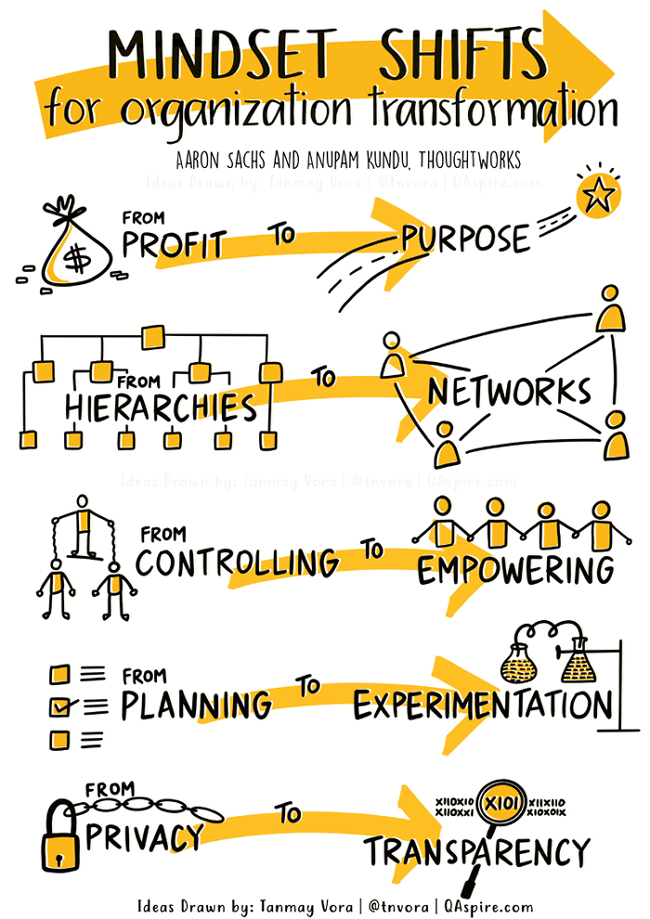
What is an Agile Company?

Lately, people often ask me what is an agile company.
They have an understanding of agile software development techniques such as Scrum, Lean Software Development, Kanban, eXtreme Programming but no clue how a company could be agile.
What does it mean to be an agile organization?
One way to approach this theme is to implement concepts of the above-mentioned agile approaches.
These are the pillars for iterative incremental improvements.
Scrum Pillars
- Transparency
-
You trust all collaborators to provide their best when working on the product. They need full access to all relevant information: quality, progress, budget, people, and financial data. They use the data to select the best alternatives to reach the company’s goals.
- Inspection
-
You cherish a failure culture because inspections will find weak points. You need a culture where people are never blamed. One consequence is that you eliminate management of objectives and bonuses in your company.
- Adaptation
-
You are ready to learn better approaches and truly believe there is a better solution. Processes change regularly bottom-up, a company’s budget can only be a rolling indicative budget, and planning has to be continuously updated.
You can also pursue desirable attitudes or values of agile persons.
Scrum Values
- Commitment
-
As an employee you want to win, you are engaged. Every manager truly believes you work best to achieve the goals. If not, this manager made a mistake by hiring or keeping you.
- Courage
-
You are ready to say “I am wrong” because being wrong opens the door for improvement.
- Focus
-
You daily optimize the customers’ value and thrive for excellence. As a developer, you do not work on projects, you work on excellent products. You provide value to your customers.
- Openness
-
You seek better ideas and ways of doing. Openness requires transparency and respect.
- Respect
-
You truly respect customers, team members, collaborators, and people. In your team, I will not hear any disrespectful comments about people.
Modern Agile
The modern agile movement defines guiding principles.
- Make people awesome
-
Dedicated collaborators want to give their best. Give them a purpose, a goal, empower them, and let them climb the mountain. Thriving people need purpose, excellence, and autonomy. They are happier, healthier, and more productive.
- Deliver value continuously
-
Maintain sustainable pace and stability, all divisions of the organization should focus on customer value. At the end of the day, successful products are the only reason you get your paycheck.
- Make safety a prerequisite
-
People do their best in their daily work, you believe in McGregor Y theory. Trust them and support them to become excellent. You shall develop self-awareness to increase safety.
- Experiment and learn rapidly
-
You make mistakes, you learn and increase continuously the delivered value. You have a learning culture, you inspect and adapt. You can react to new opportunities faster than competitors.
Self Assessment

The above concepts are comprehensible. How do you know if you are moving in the right direction? A few concrete tests help you find out if you are an agile department or company.
-
Be agile instead of doing agile. Practice the above attitudes and do not just follow a checklist
-
Nobody micromanages in your company
-
Feel accountable instead of being accountable. You want to improve, and your company as a natural part of the daily work.
-
Compliment every collaborator you are working with at least once a week instead of evaluating weaknesses and criticizing people. Do you lead by example?
-
No management by objectives MBO or bonuses are established in your company
-
Every collaborator has access to all company data, every collaborator can request process and tool changes. We favor Individuals and interactions over tools and processes
-
You want to be excellent in your work. You have a purpose and autonomy in your daily work
-
Team members take the decision to hire or to fire collaborators, not the department responsible, or the human resources group. Think about collaborators selecting their leaders, about managers being servants, about information available to all collaborators
-
Can you say these essential sentences at least three times a week?
-
the most important one word, Sorry.
-
the most important two words, Thank you.
-
the most important three words, I was wrong.
-
and the most important four words, Can I help you?
-
I truly believe that we all want a fulfilling job which improves our world. I cannot understand other reasons to spend 40 hours and more per week on something less valuable. Take the above principles and apply them to your daily work. There are universal values to establish a working atmosphere you are proud of.
I agree with all of you to desire a fulfilling job is only true if you earn enough money to pay your monthly bills.
Food for Thoughts
These ideas are not new. You can delve into empirical evidence and discussions in books written by business management professors, CEOs, and passionate agile advocates. Below is a list of mind openers (available as Amazon ebooks):
| Reinventing organizations |
A guide to creating organizations inspired by the next stage of human consciousness by Frederic Laloux, |
| Accelerate |
Building strategy agility for a fast-moving world by John P. Kotter. |
| Beyond budgeting |
How managers can break free from the annual performance trap. |
| The Leader’s Dilemma |
How to build an empowered and adaptive organization without losing control; both books by Jeremy Hope. |
| Holacracy |
the new management system for a rapidly changing world by Brian J. Robertson, |
| Deliver Happiness |
A path to profits, passion, and purpose by Tony Hsieh. |
| The Lean Startup |
How today’s entrepreneurs use continuous innovation to create radically successful businesses by Eric Ries. |
| Lean Novels |
|
| The Lean Mindset |
Ask the right questions by Mary Poppendieck. |
| Social Intelligence |
The new science of human relationships, by Daniel Goleman. |
| Management 3.0 |
Leading agile developers, developing agile leaders by Jurgen Appelo. |
| The Fifth Discipline |
The art and practice of the learning organization by Peter M. Senge. |
| Fearless Change |
Patterns for introducing new ideas; More Fearless Change: Strategies for making your ideas happen; both books by Linda Rising, |
| Excellence Novels |
|
| Google re:work |
Google blog about work environment and work techniques |
(this post was also published on LinkedIn)